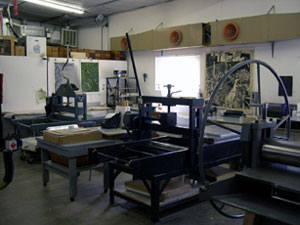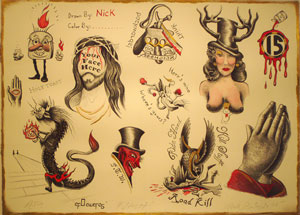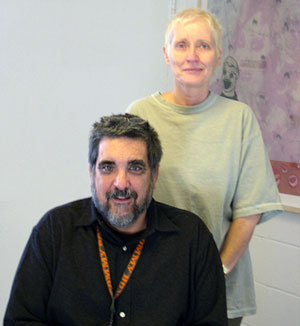Nestled in an unassuming, pale yellow brick building in east Austin, Slugfest Printmaking Workshop and Gallery supplies local, regional and national artists with a space to develop their ideas through the medium of print.
Founded in 1996 by Margaret Simpson and Tom Druecker, Slugfest has three main objectives: to provide a printmaking facility that can handle large bodies of work as well as single prints; to produce limited editions of original prints by both established and emerging artists; and to offer classes in lithography, intaglio, relief printing, monotype, book arts, alternative photo processes and letterpress.
Simpson and Druecker received their MFAs from Massachusetts College of Art and The University of Texas at Austin, respectively, and were also trained at the Tamarind Institute, at Rutgers University, and at Crown Point Press in San Francisco. They are not only the founders of Slugfest, but also its teachers, managers, and printers. Simpson and Druecker run a laidback shop with an attitude that is contagious in its enthusiasm for printmaking, providing expertise, and perhaps most importantly where printmaking is concerned, patience. Like many print shops, Slugfest is a social space. On any given day, you may find people simultaneously working on projects, having conversations, enjoying a cold beverage, or paying their dues to one of the shop’s resident felines. Printmaking is a collaborative effort by nature, as most artists require the expertise of a master printmaker to generate prints. The romantic image of a solitary artist slaving away in his or her studio doesn’t fit the context of the print shop. Instead, artists slave away in a community of like-minded people who not only share an interest in printmaking, but in making art; sounds pretty ideal, doesn’t it?
Even if you are not a printmaker, Slugfest has something to offer. In addition to the working shop’s 1,200 square feet is a small gallery, which is currently bursting at the seams with Outlaw Printmakers, featuring twenty-seven prints. On its final stop after having been to Minnesota, St. Louis, Kansas City, and New York, Outlaw Printmakers features work by Sue Coe, Michael Krueger, Peregrine Honig, Jenny Schmid, and Bill Fick, to name a few.
Organized by printmaker Tom Huck, the “Outlaws” are a well-respected group of artist-printmakers from around the country with a member list that is particularly hard to pin down. Perhaps reflecting the spaces in which they were created, the prints deal primarily with social issues. This sort of work’s historical connection to the printmaking medium is a strong one. Easily multiplied, and therefore disseminated, prints (like the Internet) have traditionally been a way to communicate to large numbers of people for very little money. The most historically well-known, Francisco de Goya and Honoré Daumier, were only able to reach a wide audience for their bitter social satires through printmaking.
While some of the work in the exhibition is conceptually heavy-handed for my taste, there are a few lovely prints in the space. A group of works by Michael Krueger made for Lawrence, Kansas’s sesquicentennial combine drawn interpretations of events in Kansas’s history with ethereal, subtly colored grounds. Often grotesque and violent, they evince a welcome connection to Goya’s Disasters of War and Los Capricios, both in content and execution. While much is said about the Outlaw’s aggressive and edgy subject matter, works like Krueger’s demonstrate that with a bit of finesse, social commentary can come off as more than a one-liner. Sue Coe, perhaps the most well known artist in the exhibition, has two small pieces: a lithograph entitled Xenotransplantation, featuring a rat with a full grown human ear grafted in its back, and an engraving, Modern Man Followed by the Ghosts of His Meat. While not the finest examples of her prints, it is hard to resist the chance to see work by someone of her stature.
What’s lacking in the show overall is a sense of subtlety, out of which the selection of a more complex, engaging group of works could emerge. There is a fine line between edgy and repulsive, and where visual communication is concerned, repulsion seems to work against the notion of art as vehicle for social critique. My requirement for this type of work is that it be visually engaging, if not initially inviting, so that there is a way into the work and inevitably the space to consider the social commentary. Works by Krueger, Lisa Bulawsky, and Michael Barnes are excellent examples of work that address social themes in a complex, inviting, and ultimately effective manner. Merging exquisite technical execution with a sophisticated approach to imagery, these works give me a reason to spend time with them. Even if you are not interested in social critique, it is worth a visit to admire the variety of printmaking techniques and their qualities that this exhibition presents.
If printmaking’s history can offer anything to a present day shop, it’s perhaps that it continues a long legacy and proven tradition. Providing the Austin community with a welcoming environment without pretense and unrivaled printmaking expertise for close to a decade, Slugfest has proven to be a stable and lasting institution. Committed both to printmaking’s viability as a medium and to supporting the artists who utilize it, Slugfest is the Austin art scene’s best kept secret.
Images courtesy of Slugfest.
Eric Zimmerman is an artist and writer living in Austin. He will receive his MFA from the University of Texas at Austin in May of 2005.






1 comment
Margie and Tom,….
Haven’t seen you in a while. Your names came up in a conversation the other day. I believe we were talking about “Dubuffet’s Uncle’s Cow” which is on our wall. I googled you and you are in Texas. Thanks to internet you can’t hide.
Antti (MassArt-88)